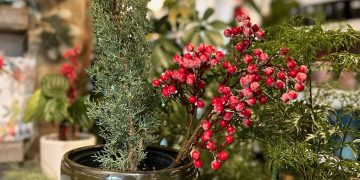The exhibit currently at the Craig Krull Gallery at Bergamot Station involves three artists (two painters, one photographer), and the landscapes of Southern California. Taken together, the different visions of Larry Cohen: “California Incline”; Bruce Everett: “Fire Roads and Creek Beds”; and Douglas Hill: “Poured in Place: 72 LA River Bridges” add up to a vicarious tour of urban, rural and oceanside scenery that finds beauty in shapes both natural and human-made.
Says gallery owner Craig Krull, “As the Incline is scheduled for major retrofitting soon, it is an appropriate time to take an aesthetic look at one of our local, but often overlooked, landmarks.” The “California Incline” installation begins with a glass case containing graphic mementos of the cliffs above Santa Monica’s North Beach – postcards, photographs and a ticket from the old Pacific Electric trolley that took visitors to Santa Monica and Venice. The old-time feeling generated by these souvenirs continues as one gazes at Cohen’s oil paintings of the same scenery. Most of the paintings are views from the top of the Incline, looking out at the ocean and the Pier. The colors range from pine tree green to subdued olive green and shades of gray, but here and there, brighter reds and yellows pop up, delineating features on the Pier and buildings by the shore. Cohen also varies the view by rendering the sky in different shades. One painting is called “California Incline, Cloudy Weather” and shows the sky covered with white and gray storm clouds as it often looks in late winter. Another painting features a dark gray-brown sky over the ocean, as on a cloudy evening. In all, there are 11 views of, or from, the Incline, proving that as with William Carlos Williams’ “Blackbird,” there are many ways that a single subject can be examined and made fresh.
Bruce Everett’s “Fire Roads and Creek Beds” features eight oil paintings, mostly large canvases, with less use of thick impasto than Cohen’s oils. The landscapes are mountainous areas in places like Cojo Ranch, Santa Maria, Tujunga and Simi Valley. The flatness of the applied paint evokes the dryness of mountainsides in dry weather and the colors are solid and intense greens, yellows, browns and tans that recreate dry creek beds and areas that look like they might ignite easily after months of drought. The colors and the largeness draw the viewer in as if the paintings were stage backdrops or back-projections on movie sets.
Douglas Hill’s photographs of bridges over the Los Angeles River are small archival pigment prints in square frames. They range from tight shots that hone in on details of bridges (such as the inevitable graffiti on the sides of some concrete bridges and river banks) to distant views of railroad bridges and freeway overpasses. One photo, alas, shows the debris that has settled into the shallow waters of the river, backed by a bright blue sky. It’s almost impossible to look at these photographs and not begin to hum the Red Hot Chili Pepper’s “Under The Bridge.”
These artists indeed have found that local landscapes can be one’s friend, as their works chronicle both nature and construction that modifies that nature with a kind of love.










